It’s not easy to pick a crossover from among all the other crossovers because so many of them are more or less the same.
One that’s different in a big way is the Mazda CX-90 – because it comes standard with an inline six cylinder engine. This bucks two trends. The first is the one that’s been trending toward the replacement of six cylinder engines with four cylinder engines, chiefly for compliance reasons. (Smaller engines use a bit less gas – hypothetically – and “emit” less of the dread gas carbon dioxide. This helps car companies comply with federal edicts requiring higher gas mileage and lower “emissions” of the dread gas CO2.)
The other is that in-line sixes are generally found under the hood of luxury-brand (and luxury priced) crossovers, such as those made by BMW.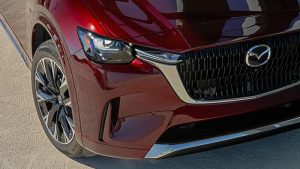
It’s getting tough to find a new crossover that’s available with even a V6. And good luck finding one with an inline six for less than $40,000 to start.
The CX-90 comes standard with one – and it costs about $38k to start.
What It Is
The CX-90 is a full-sized crossover with three rows of seats and room for 7-8 passengers, depending on the configuration – but that isn’t what makes it unusual. There are a plethora of full-sized crossovers that come with three rows of seats, among them the VW Atlas – which is one of the Mazda’s main rivals in the class.
What makes the Mazda a standout in the class is that it comes standard with a six cylinder engine at a time when the trend is to replace sixes with small (turbocharged) fours. The Atlas being a for-instance. It used to come standard with a six but now comes only with a turbo four.
And the Mazda’s six isn’t just a six.
It is an inline six rather than a V6.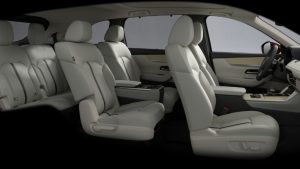
The distinction being not just the way the cylinders are arranged but also that in-line sixes are usually available only in much more expensive luxury-brand crossovers like the BMW X6 as a for-instance. It stickers for $74,500 to start. The Mazda – which comes standard with an inline six that’s bigger than the BMW’s – stickers for $37,845 to start.
In-line sixes are desirable vs. V6 engines because they are naturally smoother due to the arrangement of the cylinders. Six in a row don’t require heavy counter-balance weights added to the crank to smooth them out. They’re also more prestigious because as a rule, they are arranged front to rear rather than side to side. The front-engine/rear-drive-based layout is a big part of what you’re paying extra for when you buy a luxury-priced crossover such as the X5 as opposed to the much more common front-drive-based (and transverse-mounted engine/transaxle) that you typically get in a non-luxury-priced crossover.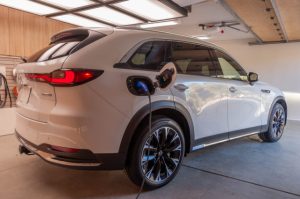
As well some luxury-priced crossovers such as the Acura MDX.
The CX-90 is also available with a four cylinder engine – paired up with a plug-in hybrid drivetrain that can go about 26 miles on a fully charged battery, which you can charge up overnight at home via a standard 120V wall outlet. This version of the CX-90 stickers for $49,945.
A top-of-the-line CX-90 Premium Plus with the plug-in hybrid drivetrain stickers for $57,950.
The CX-90 was introduced in 2024 as the replacement for the CX-9. It is also the showcase for Mazda’s new 3.3 liter in-line six cylinder engine, which is also available in the CX-70 which is basically a two-row/five-passenger iteration of the CX-90. You can read more about that one here.
The main change for the new model year is the addition of the Turbo Premium Sport trim, which comes standard with a digital/configurable instrument panel and integrated navigation system, along with a panorama sunroof, 21 inch wheels, a heads-up display (HUD), LED headlights and a Bose premium sound system, plus some trim upgrades.
There are also some slight changes in the pricing – but the base 3.3 Turbo Select trim still lists for the same as it did last year.
What’s Good
Standard in-line six bucks the trend toward standard turbo fours.
Costs less than rivals like the VW Atlas that comes only with a turbo four.
Luxury look/feel – without the luxury MSRP.
What’s Not So Good
Not as practical as the slightly larger – and significantly roomier – VW Atlas.
MSRP of the Turbo S – which has the stronger version of the 3.3 liter six – is $52,950 (a more than $10k price bump to get that stronger six).
Seating capacity of Turbo S models with the stronger version of the 3.3 liter six goes down to seven – or six – depending on the trim.
When even Lexus and Audi crossovers no longer come standard with six cylinder engines, it is happy news to discover a Mazda crossover that does.
The CX-90’s 3.3 liter inline six comes standard for lot less than Lexus and Audi money, too.
Let alone BMW money.
It comes in two different versions. The standard version makes 280 horsepower and 332 ft.-lbs. of torque. The higher-output iteration that comes standard in Turbo S models makes 340 horsepower and 369 ft.-lbs.of torque. Both versions of the six are turbocharged and augmented by a mild hybrid system that consists of a 48 volt electric system and a high-torque starting system designed to allow the engine to be shut off while the accessories are still powered and automatically turned back on extremely quickly and quietly when its power (to propel the vehicle) is needed.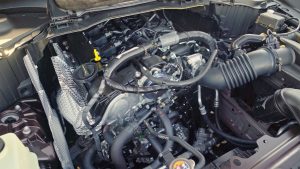
Both versions of the six tout roughly the same gas mileage numbers: 24 city, 28 highway for the 280 horsepower six and 23 city, 28 highway for the 340 horsepower version. Both also tout better gas mileage than the much smaller – and less powerful – 2.0 liter turbocharged four that comes standard in the VW Atlas, which only manages 20 city, 26 highway and tops out at just 269 horsepower.
This is interesting – because the reason for the retiring of six cylinder engines that were available in models like the Atlas is – ostensibly – that smaller engines are higher-mileage engines. Except they’re not – necessarily. Mazda gets higher mileage out of the bigger six via the mild-hybrid set-up, which allows the engine to be turned off when it’s not needed – as during deceleration/coasting and of course when the CX-90 isn’t actually moving.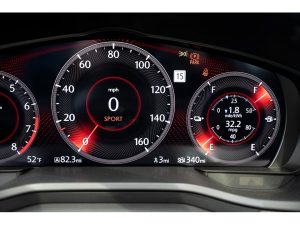
But the really remarkable thing is that even with the extra cylinders – and the extra hardware – the Mazda still costs less than the VW.
There is also the plug-in hybrid option, which swaps out the bigger six for a smaller (2.5 liter) four along with a battery pack/electric motor powerful enough to propel the vehicle at normal road speeds for about 26 miles without burning any gas at all. Or – and this is not a small deal for Mazda – “emitting” any.
Mazda – like every other vehicle manufacturer – has to figure out ways to comply with federal “emissions” edicts that now encompass CO2, a gas that was never before regulated as an “emission” because it isn’t a pollutant. The latter used to be defined as compounds that fouled the air or the environment and CO2 does not do either. It is held by some to be a cause of the “climate changing,” but no one can say exactly how nor show how C02 generated by vehicles is responsible.
Regardless, the manufacturers must reduce the “emissions” of C02 and the hybrid set-up is one way to do it. It is also a way for manufacturers such as Mazda to “get away” with selling a standard six in most CX-90s, because the low “emissions” of the hybrid counterbalance the higher “emissions” of CX-90s with the six.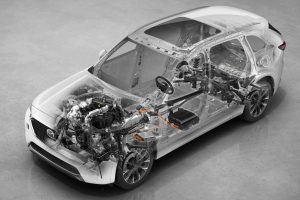
So, three cheers for the hybrid – which has more than compliance to its credit. It offers 323 horsepower – more than the standard 280 horsepower six and nearly as much as the 340 horsepower Turbo S version of the six – along with the capability to be driven a significant distance without burning any gas at all. And that could save you some gas money – though probably not enough to cover the plug-in-hybrid’s much higher buy-in cost. But you do get the benefit of the dual-fuel capability; i.e., you can drive even if you have no gas – or have no electricity.
So long as you have one – or the other.
Both the six-cylinder-powered and the plug-in-hybrid version of the CX-90 come standard with all-wheel-drive as well as an eight speed automatic transmission.
Equipped with the standard 280 horsepower version of the six, the CX-90 can pull up to 3,500 lbs. With the high-output version of the six, that goes up to 5,000 lbs. If you choose the plug-in hybrid, the maximum tow rating goes down to 3,500 lbs.
Probably because the plug-in hybrid – though nearly as powerful as the CX-90 equipped with the high-output version of the inline six – is much heavier. It weighs 5,267 lbs – vs. 4,735 lbs. for the non-hybrid CX-90. The plug-in hybrid, in other words, is already lugging around 541 extra pounds and so it can’t be expected to pull as much weight behind it as the lighter, stronger CX-90 with the high-output six.
Crossovers are vehicles you buy because you need one more so than because you want one. People buy Miatas because they want one – even if they don’t need one. No one needs a Miata. Just as no one needs a New York strip steak. Hamburger has just as much protein and you can feed more people for less.
That is why people buy crossovers. They have kids to haul. That’s a need more so than a want.
The CX-90 fulfills needs as well as wants. It is inarguably the most fun-to-drive large crossover you can buy for less than $40,000 because it is the only large crossover you can buy for less than $40k that has that sweet six. Which gets even sweeter if you can swing the price of the Turbo S.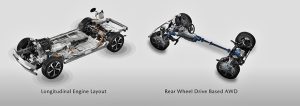
That one can hustle you to 60MPH in just over six seconds, which is the quickest 0-60 time you can buy in a large crossover for this money. A BMW X5 is quicker – and for for $20k-plus more, it ought to be. But it doesn’t sound any better. Put another way, the Mazda’s six sounds just as nice – for $20k-plus less.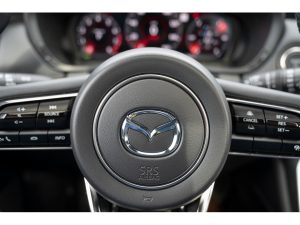
The other thing you get here that is extremely uncommon for less than $40k is a crossover that is built on a rear-drive-type of layout, meaning the engine is mounted front to back and behind it, there’s a transmission that routes power to the rear axle. Because this is an AWD model, power is also routed to the front wheels but the point is it’s not the same as the usual (at this price point) engine mounted sideways (transversely) connected to a transaxle that sends most of the power to the front wheels and some to the rear.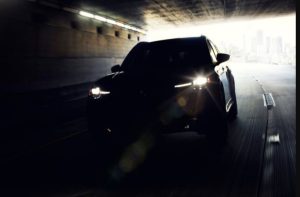
The difference in weight distribution and power distribution make the CX-90 handle and ride like luxury-brand crossovers such as the BMW X5 that also have their engines mounted front to back, with a transmission behind them that routes power to the rear wheels as the primary drive wheels, with power also sent (secondarily) to the front wheels.
It’s not a Miata, of course.
But it is a crossover for the person who wants a Miata that needs to have a crossover.
The CX-90 is probably the most stylish model in the class; it has a longer hood relative to its passenger cabin that emulates the lines of a sport sedan more so than the usual boxy/ egg shape of the typical crossover. On the downside, the CX-90 is somewhat less practical than others in the class like the Atlas that have more room inside.
Specifically, more room behind their third row – and with their second and third rows folded.
The Mazda has 15.9 cubic feet of space behind its third row – vs. 20.6 for the Atlas. With its second and third rows down, the CX-90 has 75.2 cubic feet of total cargo capacity vs. 96.6 cubic feet for the Atlas, which is almost exactly the same overall size (200.7 inches long vs. 200.8 for the Mazda).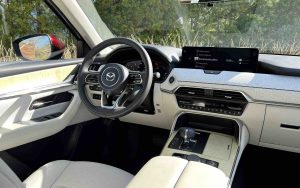
But all of this is kind of the point – in that the Mazda is meant to be an alternative to the boring usual. It has more personality – and looks to go with it – than the others. But it is still practical enough to be an alternative to the others. It has seats for up to eight people, just like them – and unless you really need every cubic inch of additional cargo-carrying capacity that’s available in models like the Atlas, you could have something that’s more attractive to look at and definitely more fun to drive.
Also more luxurious looking – and feeling.
Mazda may not be a luxury brand, per se – but the CX-90 compares favorably to those that are, especially when you have a look at what you don’t pay for the CX-90. The fact that that this crossover comes standard with an inline six for just shy of $38k when something like a BMW X5 with something similar costs nearly twice as much – and something like the Acura MDX costs about $12k more and only has room for seven people and isn’t any more “luxurious” than this merely Mazda – says a lot about the value of a luxury badge vs. the Mazda badge.
Even the base 3.3 Turbo Select trim comes standard with simulated leather seat covers, three zone climate control and a very good eight speaker audio system. The one-step-up Turbo Preferred gets real leather seat covers and a larger (12.3 inch) LCD infotainment screen.
One potential downside for some shoppers is that Turbo S models with the more powerful version of the inline six have either a two-person third row and seating for seven or second row captain’s chairs – and room for just six.
The Rest
Two small grips with this otherwise very attractive and very appealing luxury-sport (in all but badge) crossover is that it does not come with the older style rectangular charger power points but only with the new-style rounded ones. That’s fine if you have a new iPhone but it’s a minor hassle if you have an older phone with the rectangular plug.
Another is the rotary knob interface on the center console that is used to do such things as find the station you want to listen to and change channels. It requires a multi-step process of selecting options from menus to find (and operate) the control you want and the changes you’d like to make. It gets easier as you get used to using it – but it’s not as easy to use as a simple – functionally effective tuner knob that does not require finding its digital avatar in the menu array before you can make tuning changes.
The Bottom Line
The complaint that crossovers are so much the same that they’re as interesting as one bottled water vs. another is valid.
Here’s one that’s not.
. . .
If you like what you’ve found here please consider supporting EPautos.
We depend on you to keep the wheels turning!
Our donate button is here. We also accept crypto (see below).
If you prefer not to use PayPal, our mailing address is:
EPautos
721 Hummingbird Lane SE
Copper Hill, VA 24079
PS: Get an EPautos magnet or sticker or coaster in return for a $20 or more one-time donation or a $10 or more monthly recurring donation. (Please be sure to tell us you want a magnet or sticker or coaster – and also, provide an address, so we know where to mail the thing!)
If you like items like the Baaaaaa! baseball cap pictured below, you can find that and more at the EPautos store!

The bitcoin code is: 3GAfymoqSUbaFvY8ztpSoDKJWCPLrkzAmi if you’re unable to scan the QR code above!




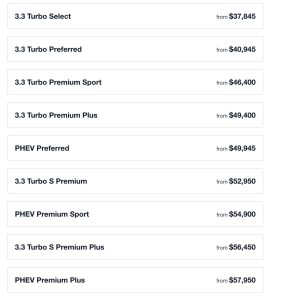
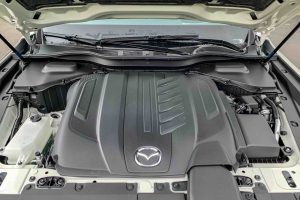



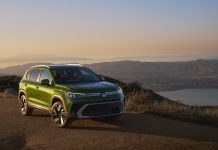





All I can find on the Mazda website are turbo powered inline 6s.
Hi Phillip,
Weird! All the data about the turbo hybrid (PHEV) version is on the Mazda media site; see here: https://news.mazdausa.com/vehicles-2025-cx-90
I threw mine out. They are in a lanndfill somewhere. Beauty covers do nothingbut trap heat.
Even with Mazda quality the long term owner ship with all that claptrap turbos, hybrid drive is worrisome. There is that guy on YouTube with the foreign accent that went thru the tear down process if something like a turbo or worse yet, the electric drive & start motor fail. The CX90 requires the front of the car to come off for many repairs.
OK for you lease and return folks but the own it 20 years plus people like me – ehh, no.
Great car (relative) and great review. The mild hybrid part scares me a little, but at least it’s not a full hybrid. The RWD aspect is a winner (for me).
I would have considered this for a vehicle I needed but I got lucky and found a new Grand Cherokee L with the 5.7L V8, when they weren’t supposed to be avail. in ’24. I learned dealers that had allotments could still get them.
We love our 2015 Mazda CX-5. Good handling, flat cornering (in comparison to its class), great brakes and super dependable. Same basic 2.5L engine that they have used for years, so no Beta testing here.
Eric,
I didn’t see it mentioned, but I assume that Mazda is still using the conventional automatic transmissions and not CVT’s? Also, are those trim levels all available with AWD?
Rented one in Denver. No heated seats on the base model. The inlne 6 feels under powered.
Not impressed.
This idea that modern vehicles are under powered is a joke.
I’ve been driving truly under powered vehicles all my life. Somehow when the light turns green, I’m usually the first one off the line, and within 10 seconds, I’m 100 – 200 yards ahead of the pack. This pack includes many cars that are capable of 6 second 0-60 times.
Sure, we aren’t racing.
The average Merican’ is afraid to use the capability they paid for.
It’s even worse when cornering is involved. Americans are largely wussified and incapable of pulling anything over about 0.15 – 0.2G despite the fact that any modern production car is easily capable of 0.7 – 0.8G on all season tires. If start pulling 0.25g on a corner, the reaction from friends and family ranges from being visibly uncomfortable to verging on complete breakout.
When we start talking about power to weight ratios of the 70s or of a VW Beetle, I’ll start to take under powered comments more seriously.
Sorry for all the typos – complete breakout was complete freakout before the Genius auto correct “fixed” it. Ugh!
I either need caffeine, to shutoff auto correct, or an edit button. Maybe all three!
Amen to that. I’ve driven 80s Mercedes diesels with manual transmission since the 80s. There is nothing slower than a 240d off the mark, but I still manage to stay ahead of traffic. And the squeals from the family when I pick a line through a modest s curve are just sad.
Nothing to do with Mazda, but an informative vlog on what many of know is coming (or worse, already here).
Hubby had the YT autocasts running yesterday morning as I was fixing breakfast. This came on and I actually sat down and watched it. I couldn’t find anything I disagreed with him on.
It is a good warning for us all on how we are being gaslit that we are not being surveyed every time we start the engine of anything newer than 10 years old.
https://www.youtube.com/watch?v=nE9IGgAS-lE
As soon as modems were paced into cars (going back as far as the introduction of OnStar) it has been game on.
Luckily the modems in those early adoption vehicles (by all OEMs not just GM) are obsolete. 3G is gone.
Some OEMs with 4G offered free upgrades to 5G. Now ask yourself why they would do that?
Sort of has a parallel to the makes or pharmaceuticals that offered a “free” shot to keep you healthy.
The slaves just keep falling for the same old tricks. It’s so frustrating!
When you put out free food for the cattle they don’t question it. It is a useful model to think of most humans as a different species. Even though all our eyes are in front, many act as prey species.
“When you put out free food for the cattle they don’t question it.”
ROTFL
Imma’ gonna’ steal that!
Tolling of the surface streets is coming.
VDOT selling the real estate in the medians of the freeways around DC and down 95 to Transurban is just a test.
Happening in NYC already. “Congestion” tolls starting on Sunday.
I think the CX-90 is still made in Japan, so should be a very high quality vehicle. Now, if they’d just get rid of the drivers assistance and other safety crap like automatic brakes, I might buy a new CX-5.
I had a 2010 CX9 & put well over 300K on it. Was a good & reliable car. Only complaint was the level of road noise.
So you open the hood to ogle that sweet inline six — and are confronted with a three-foot square of black plastic that covers the whole underhood area except for the coolant reservoirs.
What a letdown! It was understood in the era of classic luxury cars that the engine itself was a mechanical work of art. Now it’s disguised as if foul and dirty: gasoline is being burned under that black modesty sheet — Eeeekkk!!
I cannot abide the warped aesthetics and functionality of new vehicles. All I want to do is blow them up, like the Cybertruck that met its doom in Las Vegas yesterday. Fahrenheit 451, bitchez!
So true!
Yes, look at all the engine turning or fins on the Bugattis or Alphas, or even the simple elegance of the unpretentious flathead v8. I do get the sound deadening properties of the plastic and foam with modern direct injection mills clattering away, but wonder if they’re worth it.
Hi Jim. My understanding is that the plastic cover is to minimize the noise of direct injection fuel system. Maybe that’s why we’re not allowed to have nice things anymore.
Engine covers predate direct injection by at least two decades.
They began appearing in earnest by 2000 s.
They do coincide with the applianceification of automobiles in the 90s starting early on with the Luxury brands then tricking down.
Shame cause there used to be some nice looking engines out there.
I always take the beauty covers off. Mine are laying someplace in the garage.An engine should be a work of art and beauty and should admired, maybe only for us car nuts.